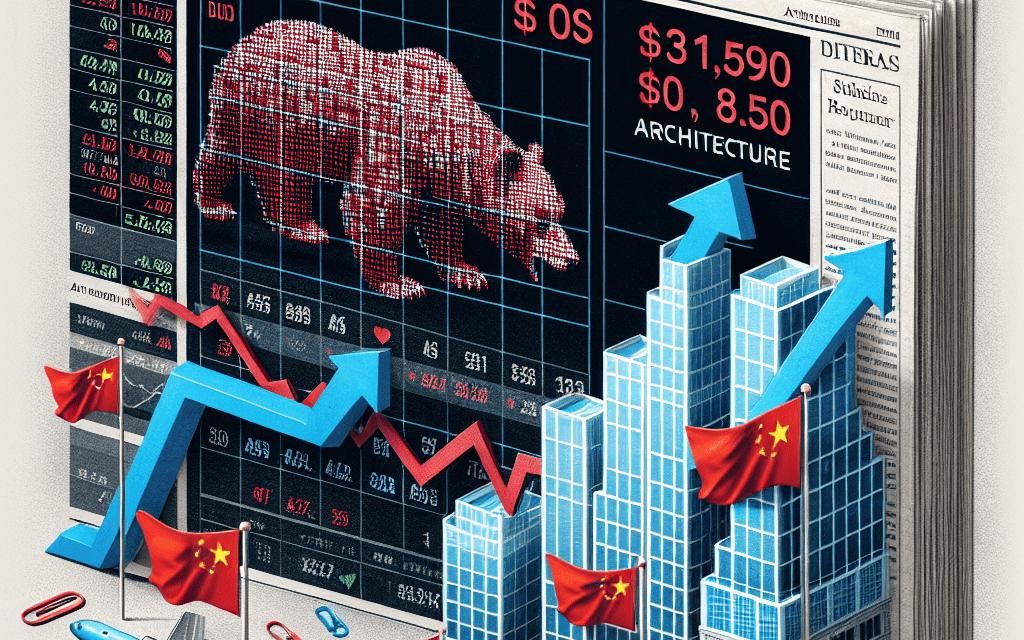“Tech Tumbles, China Climbs: A Market of Contrasts”
Introduction
Stocks experienced a downturn as a selloff in the technology sector weighed on market performance, while shares of Chinese developers saw an uptick. The tech-heavy Nasdaq index led the decline, reflecting investor concerns over valuations and potential regulatory challenges. Meanwhile, optimism surrounding policy support and easing financial conditions in China bolstered the real estate sector, leading to gains for Chinese developer stocks. This mixed market environment highlights the ongoing volatility and sector-specific dynamics influencing global financial markets.
Impact Of Tech Selloff On Global Stock Markets
The recent downturn in technology stocks has sent ripples across global stock markets, underscoring the sector’s significant influence on investor sentiment and market dynamics. As technology companies have been at the forefront of market gains in recent years, their recent selloff has raised concerns about the sustainability of their valuations and the broader implications for global financial markets. This shift in investor sentiment has been driven by a confluence of factors, including rising interest rates, regulatory pressures, and concerns over future growth prospects.
To begin with, rising interest rates have played a pivotal role in the tech selloff. As central banks around the world, particularly the Federal Reserve, signal tighter monetary policies to combat inflation, the cost of borrowing increases. This scenario tends to weigh heavily on technology stocks, which are often valued based on future earnings potential. Higher interest rates can diminish the present value of these future earnings, leading investors to reassess their positions in tech stocks. Consequently, this reassessment has led to a notable decline in the share prices of major technology firms, which in turn has exerted downward pressure on broader market indices.
Moreover, regulatory scrutiny has intensified, particularly in the United States and China, adding another layer of complexity to the tech sector’s outlook. In the U.S., antitrust investigations and potential legislative changes aimed at curbing the power of big tech companies have created an environment of uncertainty. Similarly, in China, regulatory crackdowns on technology firms have been more pronounced, with authorities implementing measures to address issues ranging from data privacy to anti-competitive practices. These regulatory challenges have prompted investors to adopt a more cautious stance, further contributing to the selloff.
In contrast to the tech sector’s struggles, Chinese property developers have experienced a resurgence, providing a counterbalance to the market’s overall performance. This rise can be attributed to recent policy shifts by the Chinese government aimed at stabilizing the real estate market. After a period of stringent regulations designed to curb excessive borrowing and speculative activities, authorities have begun to ease some restrictions, offering support to developers facing liquidity challenges. This policy pivot has been welcomed by investors, leading to a rally in the shares of Chinese property developers and injecting a dose of optimism into the market.
The juxtaposition of the tech selloff and the rise of Chinese developers highlights the interconnectedness of global markets and the diverse factors that influence investor behavior. While the tech sector’s decline has raised concerns about potential spillover effects on other industries, the resilience of Chinese developers suggests that opportunities for growth and recovery remain. As investors navigate this complex landscape, they are increasingly focused on balancing risk and reward, seeking to capitalize on emerging trends while mitigating potential downsides.
In conclusion, the recent tech selloff has underscored the sector’s vulnerability to macroeconomic and regulatory pressures, prompting a reevaluation of its role in global stock markets. At the same time, the rise of Chinese developers serves as a reminder of the dynamic nature of financial markets and the potential for policy shifts to create new investment opportunities. As these developments continue to unfold, market participants will need to remain vigilant, adapting their strategies to the evolving economic and regulatory environment. Through careful analysis and strategic decision-making, investors can navigate the challenges and opportunities presented by these market dynamics.
Reasons Behind The Recent Tech Stock Decline
The recent decline in technology stocks has captured the attention of investors and analysts alike, as the sector, once a stalwart of market growth, faces a confluence of challenges. Several factors have contributed to this downturn, each playing a significant role in shaping the current market landscape. Understanding these elements is crucial for investors seeking to navigate the complexities of the stock market.
To begin with, rising interest rates have exerted considerable pressure on technology stocks. As central banks around the world, particularly the Federal Reserve, adopt a more hawkish stance to combat inflation, borrowing costs have increased. This shift has a pronounced impact on tech companies, many of which rely heavily on borrowing to finance their growth and innovation. Higher interest rates translate to increased costs of capital, which can dampen profit margins and reduce the attractiveness of future earnings. Consequently, investors have become more cautious, leading to a selloff in tech stocks.
In addition to interest rate concerns, regulatory scrutiny has intensified, particularly in the United States and Europe. Governments are increasingly focused on curbing the influence of major tech firms, addressing issues such as data privacy, antitrust practices, and misinformation. This regulatory environment creates uncertainty for tech companies, as potential fines, operational restrictions, and increased compliance costs loom on the horizon. Investors, wary of these potential disruptions, have responded by reevaluating their positions in the tech sector.
Moreover, supply chain disruptions continue to pose significant challenges for technology companies. The global semiconductor shortage, exacerbated by the COVID-19 pandemic, has hindered production capabilities and delayed product launches. This bottleneck affects a wide range of tech products, from consumer electronics to advanced computing systems. As companies struggle to meet demand, revenue growth projections have been adjusted downward, further contributing to the decline in stock prices.
While these factors have collectively weighed on tech stocks, it is important to note the contrasting performance of Chinese developers, which have recently experienced a surge. This divergence can be attributed to several key developments in China’s real estate sector. The Chinese government has implemented measures to stabilize the property market, including easing restrictions on financing for developers and introducing policies to boost homebuyer confidence. These actions have provided a much-needed lifeline to Chinese developers, leading to a rebound in their stock prices.
Furthermore, the Chinese government’s commitment to supporting economic growth has instilled confidence among investors. As China navigates its post-pandemic recovery, policymakers have signaled their willingness to implement fiscal and monetary measures to sustain momentum. This proactive approach has reassured investors, prompting a shift in focus from the beleaguered tech sector to opportunities within China’s real estate market.
In conclusion, the recent decline in technology stocks can be attributed to a combination of rising interest rates, regulatory scrutiny, and supply chain disruptions. These challenges have prompted investors to reassess their positions, leading to a selloff in the tech sector. Meanwhile, Chinese developers have benefited from government interventions aimed at stabilizing the property market, resulting in a notable rise in their stock prices. As the market continues to evolve, investors must remain vigilant, adapting their strategies to navigate the shifting landscape and capitalize on emerging opportunities.
How China’s Real Estate Sector Is Boosting Market Confidence
In recent weeks, global financial markets have been characterized by a notable divergence in sector performance, with technology stocks experiencing a significant selloff while China’s real estate sector has shown signs of resilience and growth. This contrasting trend has captured the attention of investors and analysts alike, as it underscores the complex dynamics at play in the current economic landscape. The selloff in technology stocks can be attributed to a confluence of factors, including rising interest rates, regulatory pressures, and concerns over valuations. As central banks around the world, particularly the Federal Reserve, signal a tightening of monetary policy to combat inflation, investors have become increasingly cautious about high-growth sectors that are sensitive to interest rate changes. Consequently, technology stocks, which have been the darlings of the market for much of the past decade, are now facing headwinds as investors reassess their risk profiles.
In contrast, China’s real estate sector has emerged as a beacon of hope, providing a boost to market confidence. This development is particularly noteworthy given the sector’s recent history of volatility and regulatory challenges. The Chinese government’s efforts to stabilize the real estate market, coupled with policy measures aimed at supporting developers, have played a crucial role in restoring investor confidence. For instance, the easing of restrictions on property financing and the introduction of measures to ensure liquidity for developers have alleviated some of the immediate pressures facing the sector. As a result, shares of Chinese real estate companies have experienced a resurgence, contributing to a broader sense of optimism in the market.
Moreover, the recovery in China’s real estate sector is not only a reflection of domestic policy adjustments but also indicative of broader economic trends. The sector’s stabilization is seen as a positive signal for China’s overall economic health, as real estate plays a significant role in the country’s GDP and employment. A robust real estate market can stimulate demand for related industries, such as construction and materials, thereby creating a ripple effect that supports economic growth. This, in turn, has implications for global markets, as China’s economic performance is closely watched by international investors.
Furthermore, the rise in Chinese developers’ stocks has provided a counterbalance to the tech selloff, offering diversification opportunities for investors seeking to navigate the current market volatility. As technology stocks face pressure, the relative strength of the real estate sector presents an alternative avenue for investment, allowing market participants to adjust their portfolios in response to shifting economic conditions. This dynamic underscores the importance of sectoral diversification in managing risk and optimizing returns in an uncertain market environment.
In conclusion, the recent divergence between technology stocks and China’s real estate sector highlights the multifaceted nature of global financial markets. While the tech selloff reflects broader concerns about interest rates and valuations, the resilience of China’s real estate sector offers a glimmer of hope and stability. As investors continue to grapple with these contrasting trends, the ability to adapt and respond to changing market conditions will be crucial in navigating the complexities of the current economic landscape. Ultimately, the interplay between these sectors serves as a reminder of the interconnectedness of global markets and the need for a nuanced approach to investment strategy.
Analyzing The Correlation Between Tech Stocks And Market Volatility

The recent downturn in technology stocks has once again highlighted the intricate relationship between tech sector performance and overall market volatility. As investors navigate the complexities of the financial markets, understanding this correlation becomes crucial. The tech sector, often seen as a barometer for innovation and future growth, has a significant influence on market sentiment. When tech stocks experience a selloff, it can trigger a ripple effect across various sectors, leading to increased market volatility.
One of the primary reasons for this correlation is the substantial weight that technology companies hold in major stock indices. With giants like Apple, Microsoft, and Alphabet comprising a significant portion of indices such as the S&P 500 and NASDAQ, fluctuations in their stock prices can have an outsized impact on the broader market. Consequently, when these stocks decline, it often results in a noticeable dip in the indices, contributing to heightened volatility.
Moreover, the tech sector is inherently more volatile due to its rapid pace of innovation and the constant pressure to adapt to new technologies. This volatility is further exacerbated by the high valuations that tech stocks often command, driven by expectations of future growth. When market conditions shift, or when there is uncertainty about future earnings, these high valuations can lead to sharp corrections, as investors reassess their positions.
In addition to these factors, the interconnectedness of global markets means that developments in one region can have far-reaching implications. For instance, recent concerns about China’s economic stability have added another layer of complexity to the market dynamics. While tech stocks in the U.S. have faced pressure, Chinese developers have seen a rise, reflecting a divergence in investor sentiment. This divergence underscores the importance of considering global economic factors when analyzing market trends.
Furthermore, the role of monetary policy cannot be overlooked. Central banks, particularly the Federal Reserve, play a pivotal role in shaping market conditions through interest rate decisions and other monetary policy tools. In periods of tightening monetary policy, tech stocks, which are often seen as more sensitive to interest rate changes, may experience increased volatility. This is because higher interest rates can lead to higher discount rates for future earnings, thereby affecting the present value of these companies.
As investors seek to navigate these turbulent waters, diversification becomes a key strategy. By spreading investments across various sectors and asset classes, investors can mitigate the impact of volatility in any single sector, including technology. Additionally, staying informed about macroeconomic trends and policy decisions can provide valuable insights into potential market movements.
In conclusion, the correlation between tech stocks and market volatility is a multifaceted relationship influenced by a variety of factors, including the weight of tech companies in major indices, the inherent volatility of the sector, global economic developments, and monetary policy. As the financial landscape continues to evolve, understanding these dynamics will be essential for investors aiming to make informed decisions. By recognizing the interconnectedness of these elements, investors can better anticipate market shifts and adjust their strategies accordingly, ultimately enhancing their ability to navigate the complexities of the financial markets.
Investment Strategies Amidst Tech Selloff And China Developer Surge
In the ever-evolving landscape of global financial markets, investors are constantly seeking strategies to navigate the complexities of market fluctuations. Recently, a notable shift has been observed as stocks experienced a decline driven by a selloff in the technology sector, while Chinese developers witnessed a surge. This dynamic presents both challenges and opportunities for investors aiming to optimize their portfolios amidst these contrasting trends.
The technology sector, often regarded as a cornerstone of modern investment portfolios, has faced a significant selloff. This downturn can be attributed to a confluence of factors, including regulatory pressures, supply chain disruptions, and concerns over valuations. As tech giants grapple with these challenges, investors are prompted to reassess their strategies. Diversification emerges as a prudent approach, allowing investors to mitigate risks associated with sector-specific downturns. By spreading investments across various sectors, investors can cushion the impact of a tech selloff and maintain a balanced portfolio.
Moreover, the tech selloff underscores the importance of staying informed about macroeconomic trends and regulatory developments. Investors who remain vigilant and adaptable are better positioned to anticipate shifts in market sentiment. For instance, understanding the implications of regulatory changes on tech companies can provide valuable insights into potential risks and opportunities. By leveraging such knowledge, investors can make informed decisions that align with their long-term financial goals.
Conversely, the surge in Chinese developers presents a compelling opportunity for investors seeking growth prospects. This rise can be attributed to a combination of government support, easing of property market regulations, and increased demand for real estate. As Chinese developers capitalize on these favorable conditions, investors are presented with a chance to tap into a burgeoning market. However, it is crucial to approach this opportunity with a discerning eye, considering factors such as geopolitical risks and the potential for market volatility.
In light of these developments, a strategic approach to investment becomes paramount. Investors may consider adopting a barbell strategy, which involves balancing high-risk, high-reward investments with more stable, low-risk assets. This approach allows investors to capitalize on the growth potential of Chinese developers while maintaining a safety net through investments in more stable sectors. Additionally, incorporating emerging market funds into a diversified portfolio can provide exposure to the growth potential of Chinese developers while mitigating risks associated with individual stock investments.
Furthermore, the current market environment highlights the significance of active management. In times of volatility, actively managed funds can offer the flexibility needed to respond swiftly to market changes. Fund managers with expertise in navigating complex market conditions can identify opportunities and adjust portfolios accordingly, potentially enhancing returns for investors.
In conclusion, the recent tech selloff and surge in Chinese developers underscore the dynamic nature of global financial markets. Investors are encouraged to adopt a multifaceted approach, combining diversification, informed decision-making, and strategic asset allocation. By doing so, they can navigate the challenges posed by sector-specific downturns while capitalizing on emerging opportunities. As the market landscape continues to evolve, staying informed and adaptable remains key to achieving long-term investment success.
The Role Of Government Policies In China’s Real Estate Market Recovery
The role of government policies in China’s real estate market recovery has become increasingly significant as the nation navigates through a period of economic uncertainty. In recent years, China’s real estate sector has faced numerous challenges, including a slowdown in growth, mounting debt levels, and a crisis of confidence among investors. However, recent developments suggest that government interventions are playing a crucial role in stabilizing and potentially revitalizing this critical sector.
To begin with, the Chinese government has implemented a series of policy measures aimed at addressing the financial strains faced by property developers. These measures include easing restrictions on bank lending to developers, which has provided much-needed liquidity to companies struggling with debt obligations. By allowing banks to extend more credit, the government is effectively reducing the risk of defaults and bankruptcies, thereby restoring some degree of confidence in the market. This move is particularly important given the significant role that real estate plays in China’s economy, contributing to a substantial portion of GDP and employment.
Moreover, the government has also taken steps to stimulate demand in the housing market. For instance, policies have been introduced to make homeownership more accessible to first-time buyers and to encourage investment in residential properties. These initiatives include reducing down payment requirements and offering tax incentives for home purchases. By making it easier for individuals to buy homes, the government is not only supporting the real estate sector but also addressing broader economic goals, such as boosting consumer spending and promoting urbanization.
In addition to these demand-side measures, the Chinese government has also focused on supply-side interventions. One notable approach has been the promotion of urban renewal projects, which aim to revitalize aging urban areas and create new opportunities for real estate development. These projects are often supported by public-private partnerships, which leverage both government resources and private sector expertise. By facilitating the redevelopment of urban spaces, the government is helping to create a more dynamic and sustainable real estate market.
Furthermore, the government’s commitment to maintaining financial stability has led to the implementation of regulatory reforms designed to enhance transparency and accountability within the real estate sector. These reforms include stricter oversight of financial practices and improved disclosure requirements for property developers. By fostering a more transparent and accountable market environment, the government is working to rebuild trust among investors and stakeholders, which is essential for long-term recovery.
While these policy measures have shown promise, it is important to recognize that the path to recovery is not without challenges. The global economic environment remains uncertain, and external factors such as trade tensions and geopolitical risks could impact China’s real estate market. Additionally, the effectiveness of government policies will depend on their timely and coordinated implementation, as well as the ability of local governments to adapt to changing conditions.
In conclusion, government policies are playing a pivotal role in China’s real estate market recovery by addressing both financial and structural challenges. Through a combination of demand and supply-side measures, regulatory reforms, and strategic interventions, the government is working to stabilize the market and lay the foundation for sustainable growth. As the situation continues to evolve, the ongoing commitment of policymakers to support the real estate sector will be crucial in ensuring its resilience and contribution to China’s broader economic objectives.
Future Outlook: Tech Stocks Versus Chinese Developers In Global Markets
In recent months, the global financial markets have experienced a notable shift, characterized by a selloff in technology stocks juxtaposed with a rise in Chinese developer equities. This dynamic has prompted investors and analysts to reassess their strategies and forecasts, as the interplay between these two sectors could significantly influence future market trends. As we delve into the future outlook for tech stocks and Chinese developers, it is essential to consider the underlying factors driving these movements and their potential implications for global markets.
The technology sector, long regarded as a cornerstone of modern economic growth, has recently faced headwinds that have led to a decline in stock prices. Several factors contribute to this downturn, including regulatory pressures, supply chain disruptions, and concerns over valuations. Regulatory scrutiny, particularly in the United States and Europe, has intensified as governments seek to address issues related to data privacy, antitrust, and market dominance. These regulatory challenges have created an environment of uncertainty, prompting investors to reevaluate the growth prospects of major tech companies.
Moreover, the ongoing supply chain disruptions, exacerbated by the COVID-19 pandemic, have further complicated the outlook for tech stocks. Semiconductor shortages, shipping delays, and rising production costs have hindered the ability of technology firms to meet consumer demand, thereby impacting their revenue streams. Additionally, concerns over inflated valuations have led some investors to question whether the current prices of tech stocks accurately reflect their long-term growth potential. As a result, there has been a noticeable shift in investor sentiment, with some opting to reduce their exposure to the tech sector.
In contrast, Chinese developers have experienced a resurgence in investor interest, driven by a combination of policy support and market dynamics. The Chinese government has implemented measures to stabilize the real estate sector, which has historically been a significant driver of economic growth in the country. These measures include easing credit conditions, reducing interest rates, and providing financial support to distressed developers. Consequently, investor confidence in Chinese developers has been bolstered, leading to a rise in their stock prices.
Furthermore, the relative undervaluation of Chinese developer stocks compared to their global counterparts has attracted value-seeking investors. As the Chinese economy continues to recover from the pandemic-induced slowdown, the real estate sector is poised to benefit from increased demand for housing and infrastructure development. This positive outlook has prompted investors to reassess the potential of Chinese developers as a viable investment opportunity.
As we look to the future, the contrasting trajectories of tech stocks and Chinese developers underscore the importance of diversification in investment portfolios. While the technology sector remains a critical component of global economic growth, the challenges it faces highlight the need for investors to remain vigilant and adaptable. On the other hand, the resurgence of Chinese developers presents an opportunity for investors to capitalize on the growth potential of emerging markets.
In conclusion, the current market dynamics suggest that a balanced approach, incorporating both tech stocks and Chinese developers, may be prudent for investors seeking to navigate the complexities of global markets. By staying informed and responsive to evolving trends, investors can position themselves to capitalize on opportunities while mitigating risks. As the global economic landscape continues to evolve, the interplay between these sectors will undoubtedly play a crucial role in shaping the future of financial markets.
Q&A
1. **Question:** What caused the recent decline in stock markets?
– **Answer:** The decline was primarily due to a selloff in technology stocks.
2. **Question:** Which sector experienced a rise amidst the market changes?
– **Answer:** Chinese developers saw a rise in their stock prices.
3. **Question:** How did the tech selloff impact major indices?
– **Answer:** Major indices fell as technology stocks, which have significant weight in these indices, declined.
4. **Question:** What external factors contributed to the tech selloff?
– **Answer:** Concerns over rising interest rates and regulatory pressures on tech companies contributed to the selloff.
5. **Question:** How did Chinese developer stocks perform relative to the broader market?
– **Answer:** Chinese developer stocks outperformed the broader market, showing gains while other sectors declined.
6. **Question:** What was the investor sentiment towards Chinese developers?
– **Answer:** Investor sentiment was positive towards Chinese developers, likely due to policy support or positive news specific to the sector.
7. **Question:** What are the potential implications of this market shift for future trading sessions?
– **Answer:** The market shift could lead to increased volatility and sector rotation as investors reassess their portfolios in response to changing economic conditions and regulatory environments.
Conclusion
The recent market activity saw a decline in technology stocks, driven by a selloff that impacted major indices. This downturn in the tech sector was contrasted by a rise in Chinese developer stocks, which gained momentum due to positive developments or investor sentiment in that region. The mixed performance highlights the ongoing volatility and sector-specific dynamics within global markets, reflecting investor reactions to economic indicators, geopolitical factors, and sector-specific news. As markets continue to navigate these complexities, investors remain watchful of further developments that could influence future market trends.





